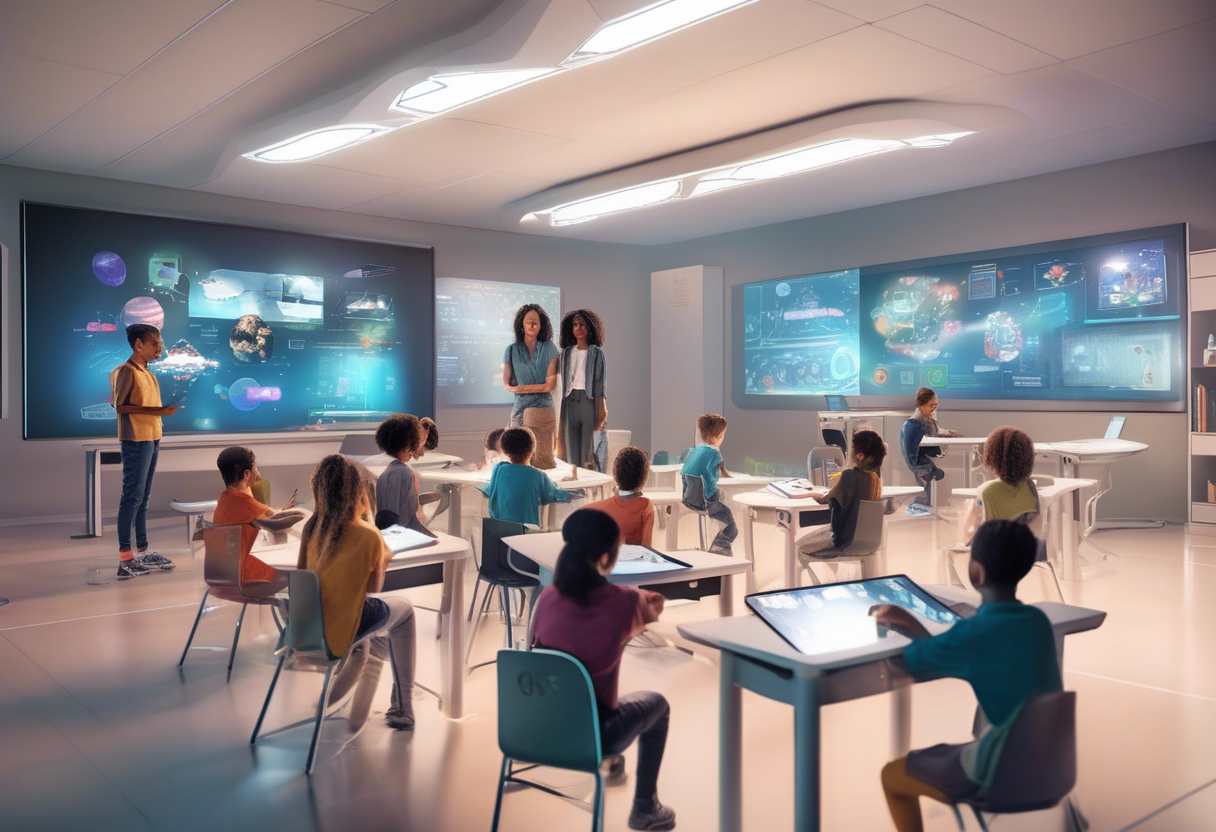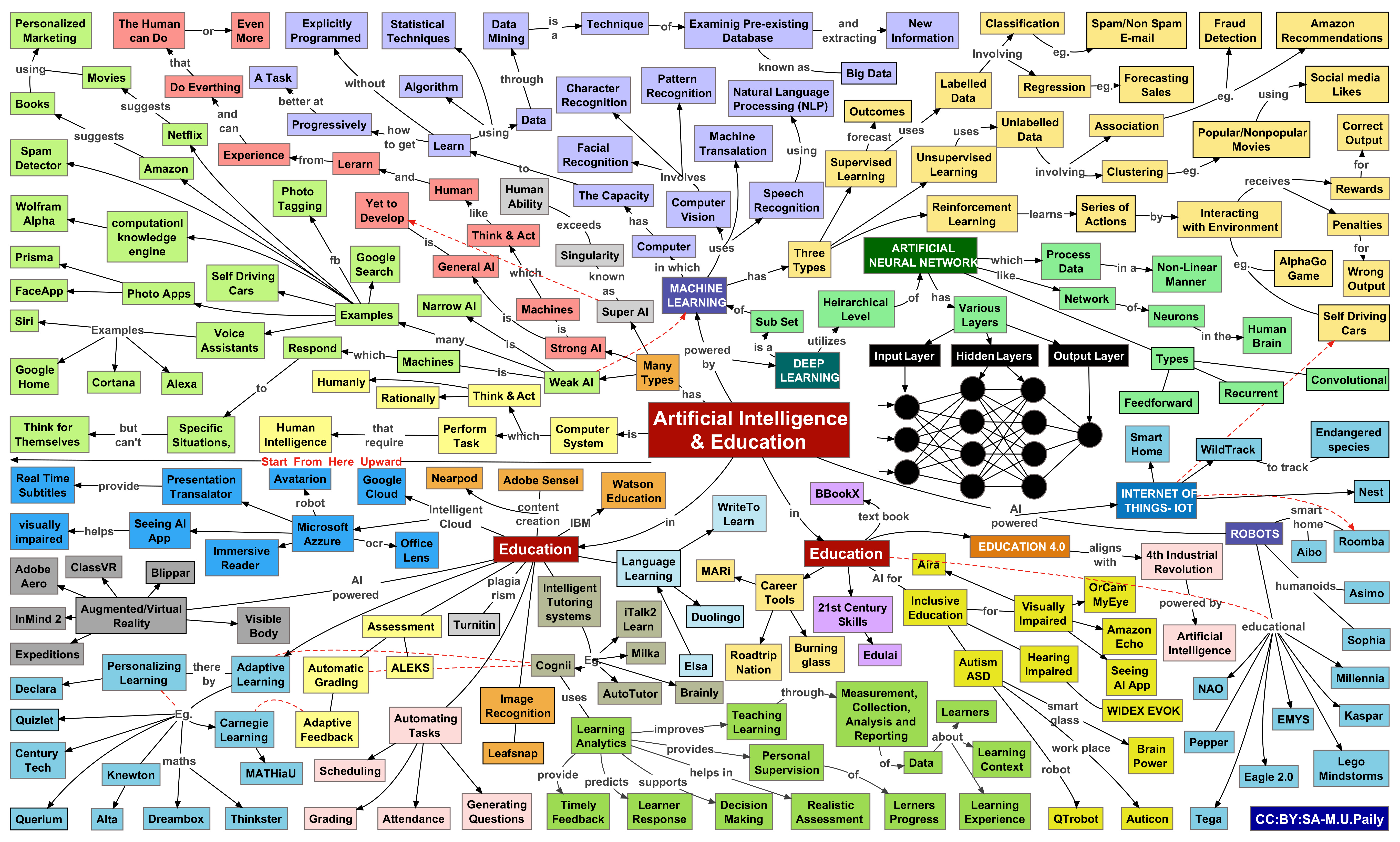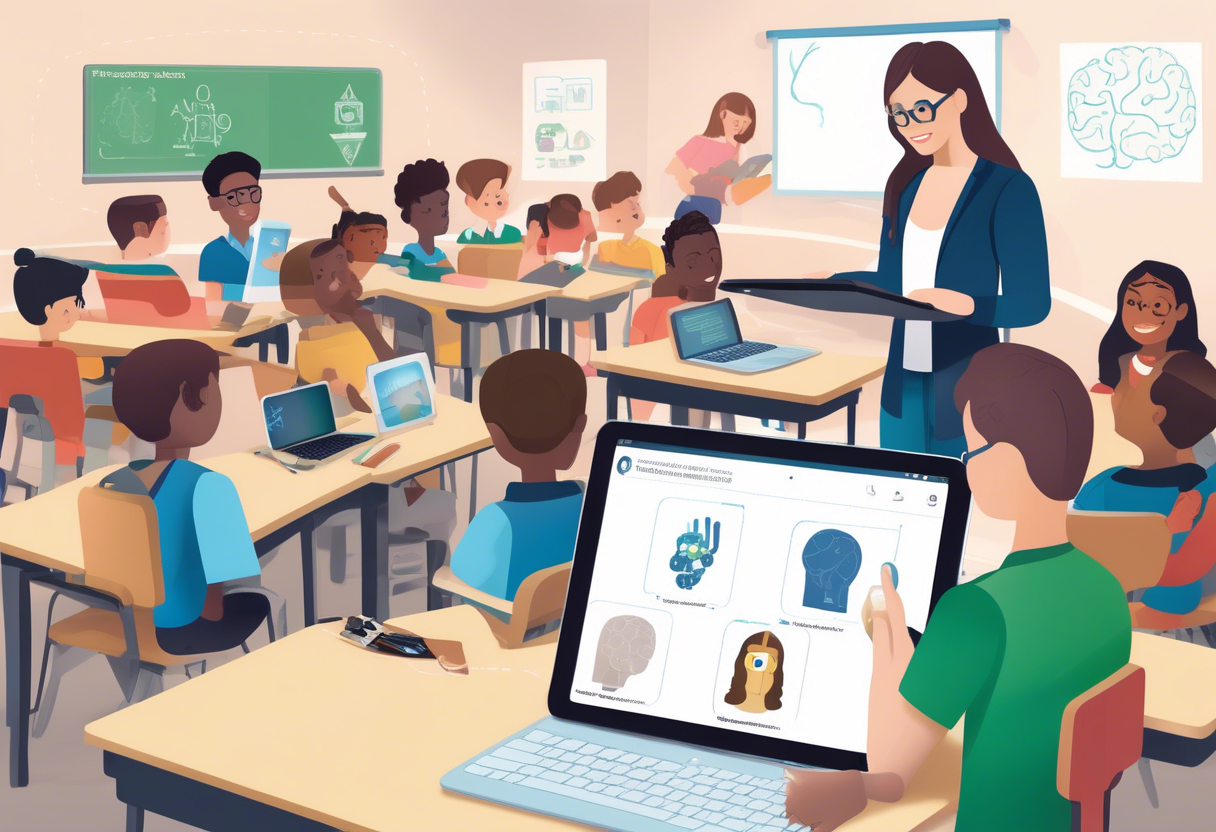
Imagine a classroom where each student's learning path fits their needs, speed, and style. That's what adaptive learning technologies aim to do by 2025. These tools offer a learning experience that changes with how a student is doing. Schools using these platforms have noticed a 30% boost in how engaged and well students understand the material. But how do these technologies work, and why are they so effective? In this article, we'll break down how adaptive learning technologies operate, how they're being used, and the benefits they bring to students and teachers. We'll also look ahead to see what's next for this cool educational tool. Let's get started!
Exploring Adaptive Learning Technologies for 2025
Defining Adaptive Learning Technologies
Adaptive learning technologies leverage AI and machine learning to personalize education. By adjusting content, difficulty, and learning paths based on individual student performance, these systems provide immediate feedback and allow students to concentrate on areas needing improvement. The technology continuously monitors student progress, tailoring lessons to meet specific needs. These digital platforms dynamically adjust materials and assessments to enhance the learning experience.
Significance of Personalization in Adaptive Education
Personalization in education engages students by aligning content with their strengths, weaknesses, and learning pace, reducing frustration and boredom. It promotes equitable learning by offering additional support to those who need it and presenting more challenging tasks to advanced learners.
With personalized adaptive settings, students can progress at their own speed, fostering a deeper understanding of the material. These technologies have the potential to transform classroom dynamics, enabling teachers to effectively manage larger classes and address the diverse needs of all students.
Step-by-Step: Implementing Adaptive Learning Technologies
Comprehensive Planning for Adaptive Learning Implementation
Identify Learning Gaps and Target Audiences for Adaptive Learning
To kick off your journey with adaptive learning technology, it's crucial to identify learning gaps, define your target audience, and set clear objectives. Start by evaluating the current learning environment to pinpoint areas where students may struggle. Engaging with teachers, students, IT personnel, and administrators provides a well-rounded perspective. This collaborative approach ensures that the adaptive technology you select aligns with learners' genuine needs.
Utilize surveys, interviews, and focus groups to gain valuable insights into areas that require improvement. Additionally, assessing the readiness of teachers, students, and parents for adaptive learning is essential. Keeping educators and parents informed from the beginning helps address any concerns they might have.
Define Organizational Objectives and Success Metrics for Adaptive Learning
Clearly articulate the purpose of integrating adaptive learning technology. These objectives should align with broader educational goals, such as enhancing student engagement or improving learning outcomes. Establishing clear, measurable success metrics is essential to evaluate the program's effectiveness. Metrics could include student performance, engagement levels, or feedback from learners and educators. These indicators help assess success and guide necessary adjustments.
Evaluate Technological Infrastructure for Adaptive Learning
Review System Compatibility for Adaptive Learning Integration
Examine your existing technological setup to determine if it can support adaptive learning technology. Consider factors such as hardware, network speed, and software systems. Identifying any limitations or areas needing upgrades is crucial to ensure the new technology is well-supported. Compatibility with current systems is vital for smooth operation.

Ensure LMS Integration with Adaptive Learning Tools
Ensure that the adaptive learning technology you choose integrates seamlessly with your current Learning Management System (LMS) and other educational platforms. This involves checking data exchange, user interface, and functionality. Integration should create a cohesive learning experience, allowing educators and learners to access everything they need from a single platform. Collaborating with IT experts can help address any technical challenges and ensure a smooth integration.
Select Adaptive Learning Tools and Technologies
Choose Adaptive Platforms with Personalized Learning and Analytics
Select adaptive learning platforms that offer personalized learning paths tailored to individual needs. These platforms should leverage data analytics to track progress and identify strengths and weaknesses. Features such as real-time feedback and adaptive assessments are crucial for a customized learning experience. Evaluate platforms based on their ability to adapt to different learning styles and provide valuable data insights.
Opt for Flexible and Scalable Adaptive Learning Tools
Opt for adaptive learning tools that can evolve with educational needs. They should integrate seamlessly with your current LMS. Scalability is essential to accommodate more users and content, while flexibility allows for customized learning experiences and adaptation to changing goals and technology.
Design and Customize Adaptive Learning Content
Develop Modular, Objective-Based Adaptive Lessons
Create adaptive content in modules, each focusing on specific learning objectives. This approach allows learners to progress at their own pace, mastering each module before advancing. Modular content supports personalized learning by enabling learners to concentrate on areas needing improvement. Collaborating with subject experts ensures content accuracy and relevance.
Implement Formative Assessments and Feedback in Adaptive Content
Include formative assessments within the adaptive content to evaluate understanding and provide practice. These assessments should vary, such as quizzes or interactive exercises. Providing specific, actionable feedback is crucial for guiding learners on improvement. Feedback should be personalized to meet individual needs and encourage progress.
Develop Adaptive Learning Pathways
Structure Adaptive Content from Basics to Advanced
Structure adaptive learning pathways by organizing content from foundational to advanced topics. This ensures learners build a solid foundation before tackling more complex material. Pre-assessments can determine each learner's starting point, allowing them to skip content they already know. This setup supports efficient learning and reduces frustration.
Leverage AI Recommendations for Adaptive Learning
Leverage AI-driven recommendations to guide learners through adaptive pathways. AI can analyze data to identify knowledge gaps and suggest appropriate content and activities. These recommendations personalize learning, ensuring learners receive the right support at the right time. AI insights also help educators provide targeted assistance, enhancing learning outcomes.
Create Assessments and Feedback Mechanisms for Adaptive Learning
Align Adaptive Assessments with Learning Objectives
Design assessments that align with the learning objectives of each module. This ensures assessments accurately measure understanding and progress. Employ various assessment types, such as multiple-choice or project-based tasks, to evaluate different knowledge aspects. Ensure assessments are fair and reliable.
Provide Detailed Feedback for Adaptive Learner Guidance
Provide detailed feedback for each assessment to guide learners. Highlight strengths and areas for improvement, offering specific suggestions. Use positive language and constructive criticism to motivate learners. Detailed feedback helps learners reflect and develop strategies for success.
Pilot the Adaptive Learning Program
Conduct a Pilot Test for Adaptive Learning Effectiveness
Begin by implementing the adaptive learning program on a small scale to test its effectiveness. Select a sample of learners and educators for the pilot to identify issues and gather feedback before a full rollout. Monitor the pilot closely to evaluate its impact.
Collect Feedback to Refine Adaptive Learning Program
Collect feedback from participants in the pilot to identify areas for improvement. Use surveys and interviews to gather insights into user experience and challenges. Analyze feedback to refine the program, addressing content, technology, and support issues.
Train Educators and Administrators for Adaptive Learning
Offer Technical and Pedagogical Training for Adaptive Learning
Offer comprehensive training for educators and administrators on adaptive learning technology. Cover system navigation, troubleshooting, and data analysis for technical training. Focus on integrating adaptive learning into teaching for pedagogical training. Make training hands-on and interactive.
Implement Initial and Ongoing Adaptive Learning Training
Include initial training and ongoing refreshers to keep educators and administrators proficient. Regular updates should cover new features and best practices. Ongoing development is crucial for high-quality instruction and maximizing benefits.
Roll Out the Adaptive Learning Program Strategically
Expand Adaptive Learning Implementation Gradually
Expand the adaptive learning program gradually, using insights from the pilot. A phased rollout allows for resource management and issue resolution. Use pilot data to inform scaling decisions and make necessary adjustments.
Assess Organizational Readiness for Adaptive Learning
Assess the organization's readiness for full-scale implementation. Evaluate technological infrastructure, staff capacity, and support to determine timing and approach. Ensure all stakeholders are prepared and equipped for success.
Provide Ongoing Support and Resources for Adaptive Learning
Establish Continuous Support for Adaptive Learning Users
Establish continuous support for educators and learners through regular check-ins and communication. This should include technical assistance and pedagogical guidance. Regular check-ins help identify and address challenges early.
Create an Online Resource Base for Adaptive Learning Support
Develop an online resource base with tutorials and FAQs to support users. Keep it updated with new developments. Establish responsive help channels, such as live chat, for immediate assistance. Comprehensive support is key for user satisfaction and success.
Monitor and Optimize the Adaptive Learning Experience
Utilize Data Analytics to Track Adaptive Learner Progress
Utilize data analytics to track learner progress and engagement. Analyze data such as time spent, scores, and interactions to gain insights. This helps identify trends and informs content and strategy decisions.
Make Data-Driven Adjustments to Adaptive Learning Content
Adjust content and delivery based on data insights. Modify content to better meet learner needs, adjust pacing, or try new strategies. Regularly review and optimize the learning experience to keep it relevant and effective.
For more information on implementing adaptive learning technologies, visit Paradiso Solutions, Adobe eLearning, and APLU Adaptive Courseware Implementation Guide.
Benefits of Adaptive Learning Technologies for Students and Educators
Adaptive Learning: Transforming Student Experiences
Adaptive learning technology is a game-changer for students. It offers real-time progress tracking and feedback, enabling students to rectify mistakes early and reinforce positive learning habits. These systems refine the curriculum by eliminating unnecessary repetition and focusing on challenging areas, thereby accelerating the learning process.
Moreover, adaptive learning solutions enhance accessibility by presenting content in various formats, difficulty levels, and languages. Leveraging machine learning, these systems customize content and assessments to help bridge achievement gaps. Studies indicate a 59% improvement in academic performance and engagement. For instance, at Arizona State University, course completion times have been reduced by 33%.
AI-Driven Tools: Empowering Educators
Adaptive learning tools equip teachers with detailed insights into student performance, facilitating targeted support and interventions. By automating routine assessments and providing instant feedback, these tools reduce the teachers' workload, allowing them to concentrate on more critical teaching tasks.

Furthermore, these tools enable curriculum adjustments based on student data, optimizing the use of time and resources. Teachers have observed increased student engagement and motivation, which helps address individual learning needs and promotes equity. Platforms like 2hr Learning streamline lessons, ensuring students master topics before progressing, thereby enhancing teaching effectiveness.
Future Trends in Adaptive Learning Technologies
Innovations in Adaptive Learning Technologies
AI is at the forefront of adaptive learning technologies, revolutionizing the educational landscape. By analyzing detailed data, AI customizes learning experiences in real-time, ensuring content is dynamically tailored to individual needs.
Natural Language Processing (NLP) enhances interactions through conversational interfaces, providing quick and intuitive responses. Generative AI plays a pivotal role in crafting personalized content and supporting learners with disabilities.

Moreover, immersive technologies such as Augmented Reality (AR) and Virtual Reality (VR) are transforming how learners engage with material, making education more captivating and interactive.
In addition, mobile learning and microlearning are breaking down educational content into manageable, bite-sized pieces, promoting more efficient learning. Advanced analytics further enhance this process by identifying potential issues in real-time, thereby boosting overall success rates.
Addressing Challenges in Adaptive Learning Technologies
As adaptive learning technologies advance, addressing concerns around ethics, data privacy, and transparency becomes crucial. Platforms are implementing encryption and seeking user consent to comply with regulations like GDPR, fostering trust among learners by being transparent about data usage.
Ensuring digital equity is also essential, which means technology must accommodate a diverse range of learners. Features such as voice-activated tools can help achieve this inclusivity.
Balancing technological innovation with ethical considerations is vital for sustainable success. Platforms should adhere to regulatory standards, minimize biases, and support learners with disabilities through accessible features like voice-activated navigation.
Adaptive Learning Technologies: Frequently Asked Questions
Future of AI-Driven Adaptive Learning Platforms by 2025
By 2025, adaptive learning platforms are set to become significantly more intelligent. They will offer personalized learning paths, adjusting in real-time to meet each learner's needs. AI and machine learning will enhance content recommendations by modifying the difficulty, type, and sequence of lessons to ensure a smoother learning experience. These platforms will leverage data analytics to monitor performance and tailor the learning journey, creating an equitable environment for all learners.
Imagine an AI-driven platform assessing a student's progress, adjusting lesson difficulty, and recommending resources to facilitate learning at an individualized pace (source).
Ethical Considerations in Adaptive Learning Technologies
Ethical considerations in AI-driven education focus on ensuring equal access to adaptive learning tools to prevent widening educational disparities. Privacy and data security are paramount, given these systems track learners' strengths and weaknesses. Transparency in AI decision-making is essential to build trust among educators and students. Schools must safeguard student data and ensure that AI adjustments do not introduce bias (source).
Role of AR and VR in Enhancing Adaptive Learning Technologies
Immersive technologies such as AR and VR can significantly enhance adaptive learning by providing interactive, multi-sensory experiences tailored to individual learning paths. These technologies enable students to engage in simulations and hands-on practice within safe environments, dynamically adjusting based on performance.

AR and VR captivate learners, accommodate diverse learning styles, and increase motivation within personalized frameworks. Envision a VR chemistry lab that adapts the complexity of experiments to a student's mastery level and provides immediate feedback (source).